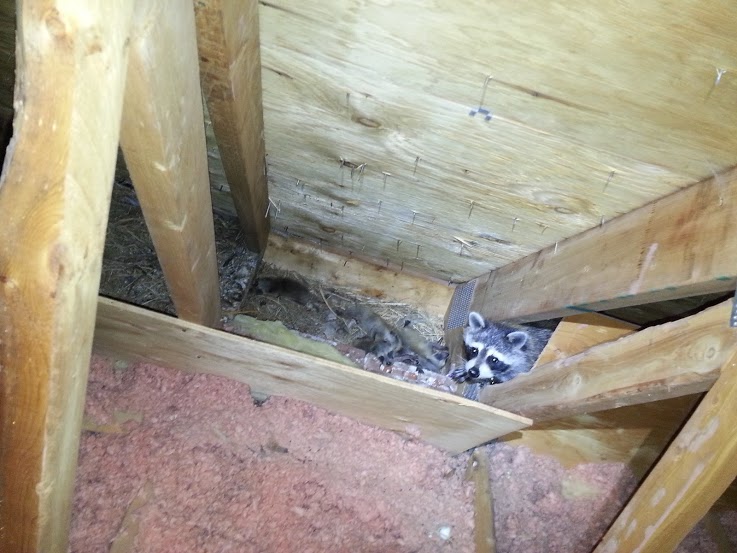As the Hennepin County homeowners can attest, raccoons are a common issue in the area. With their cunning nature and ability to adapt to urban environments, they can cause significant damage to yards and homes. But, are raccoons nocturnal animals? This question is important to consider when devising a plan for raccoon removal in Hennepin County. Understanding the behavior of these animals can help homeowners determine how to get rid of raccoons and prevent future infestations.
In this blog article, our Skedaddle experts will examine the nocturnal habits of raccoons, providing valuable insight into how to control their presence on your property. Whether you’re dealing with a current issue or simply want to be prepared for potential future encounters, our informative discussion will provide useful tips and strategies for keeping these mischievous animals at bay.
Decoding the Nocturnal Nature of Raccoons
Raccoons, known scientifically as Procyon lotor, are native to North America and have been increasingly observed in urban areas. Although they have become in many ways urban animals, they have maintained their natural nocturnal instincts.
Rather than being strictly nocturnal, they are more accurately described as crepuscular, meaning their peak activity levels occur during twilight hours – dawn and dusk. These hours allow them to take advantage of the muted light to forage for food while avoiding the harsh heat of the day and the total darkness of night.
Why are They Nocturnal?
The nocturnal tendencies of these animals stand as an evolutionary adaptation providing them with numerous survival advantages. Many of their natural predators, such as cougars and bobcats, are less active during the night, providing them with a safer environment to perform essential tasks like eating and mating.
Nocturnal behavior also allows them to take advantage of food sources that may not be available during the day. They are omnivores, feeding on a variety of foods such as fruits, plants, nuts, insects, and small rodents. However, in urban environments, they have been known to forage in garbage cans, demonstrating their flexibility and adaptability.
Nocturnal Habits and Home Invasion
The creative and adaptable nature of raccoons, combined with their nocturnal habits, often leads to conflicts with homeowners. They are attracted to homes because they offer plentiful food sources and potential nesting sites, especially during the daylight hours when they seek a quiet, safe place to rest.
Having a clear understanding of their habits, including their nocturnal nature, can be a significant step in mitigating the issues they can cause. Proper preventative measures and contacting an experienced wildlife control company, like Skedaddle, play important roles in dealing with these animals.
Raccoons After Dark: Exploring their Nightly Activities
During the cover of the night, they are undoubtedly at their busiest. Their primary activities center around two main pursuits: foraging for food and seeking shelter. With less overall activity around them and a reduced risk from predators, they capitalize on this time to ensure survival and growth.
At the edge of darkness, the first order of business for raccoons is to find nourishment. As previously mentioned, they are omnivores with a notably diverse diet. They are known to eat just about anything they can find – whether it be from a forest floor or a trash bin. Their adaptability has led them to scavenge in our gardens and trash cans, contributing to their reputation as troublesome neighbors.
Shelter Seeking: A Common Nightly Activity
Aside from scavenging for sustenance, they are also vested in finding suitable shelter where they can rest during the day. Their ideal habitats, other than in woods or marshy areas, are often uncovered in human homes and structures. They are particularly partial to attics, crawlspaces, decks, and sheds, for their relative warmth and safety.
Yet, the matter of fact is that these ‘guests’ are anything but benign. Raccoons in your home present potential risks. They can cause extensive property damage, chewing on wires and disrupting home systems, as well as health issues as potential carriers of infectious diseases.
Urbanization and Raccoon Adaptation
In response to increasing urbanization, they have modified their behavior, including their night-time activities. Over the years, they’ve adapted remarkably well to living in city environments. Often, upon stumbling across an area with easily accessible food and shelter – such as a populated neighborhood – they will adjust their nightly routines to take advantage of these readily available resources.
Understanding their behavior, particularly their nocturnal habits, is the first step towards cohabiting peacefully with these animals. By taking proactive measures, you can deter them from invading your space. When in doubt, don’t hesitate to reach out to a professional wildlife control company like Skedaddle that specializes in humane raccoon removal.

How to Prevent a Raccoon Invasion of Your Home
Protecting your home from raccoons can appear daunting, but implementing a few simple strategies can go a long way toward keeping your property safe and raccoon-free. By understanding their behavior and adapting accordingly, you can significantly reduce the likelihood of an unwanted encounter with these nocturnal visitors.
- Secure All Outdoor Trash Cans
Being omnivores, they are drawn to a wide range of foods. As such, your trash cans can seem like an enticing buffet to them. To prevent attracting them, ensure your outdoor containers are securely closed at all times. This can be done using a heavy-duty strap or installing a lock on the lid, which will prevent raccoons from gaining access.
- Fortify Your Home
They are excellent climbers and can easily gain access to your home or property through exposed areas. Regularly inspect your property, paying special attention to your roof, attic, basement, and the spaces underneath decks or porches. If you find signs of possible entry points, ensure they’re promptly sealed up or covered with heavy mesh wiring which they can’t chew through.
- Regularly Clean and Inspect Your Yard
A clean yard with less clutter and fallen food sources such as fruit or nuts is less likely to attract raccoons. Also, keeping your shrubbery trimmed can eliminate potential hiding or nesting spots. If you have a garden, use fencing to secure the area and prevent them from snacking on your produce.
- Enlist the Help of Professionals
If all else fails, don’t hesitate to enlist the help of professionals. They are incredibly intelligent and adaptive animals, making them challenging to deal with on your own. At Skedaddle, we have years of experience dealing with raccoons and are equipped with the knowledge and resources to safely and humanely remove these nocturnal visitors from your property.
Please remember, it is important to never attempt to handle or capture raccoons on your own. These are wild animals and can be dangerous when cornered or threatened. Always seek professional help when dealing with wildlife.
At Skedaddle, our first priority is to ensure your safety and the humane treatment of animals. Providing humane raccoon removal services throughout Hennepin County, we take pride in approaching each situation with a high degree of professionalism, expertise, and compassion for wildlife.
Call Skedaddle for Humane Raccoon Removal in Hennepin County
When raccoons turn your quiet home into a bustling nocturnal playground, remember that you don’t have to face them alone. We’re here to help you reclaim your home while ensuring the raccoons are dealt with in a humane and eco-friendly manner. Don’t wait for the invasion to escalate. Give Skedaddle a call today and say goodbye to your nocturnal visitors once and for all.



